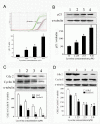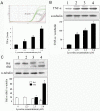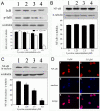Up-regulation of p21 and TNF-alpha is mediated in lycorine-induced death of HL-60 cells
- PMID: 20682078
- PMCID: PMC2924328
- DOI: 10.1186/1475-2867-10-25
Up-regulation of p21 and TNF-alpha is mediated in lycorine-induced death of HL-60 cells
Abstract
Background: Leukemia is one of the most life-threatening cancers today, and acute promyelogenous leukemia (APL) is a common type of leukemia. Many natural compounds have already been found to exhibit significant anti-tumor effects. Lycorine, a natural alkaloid extracted from Amaryllidaceae, exhibited anti-leukemia effects in vitro and in vivo. The survival rate of HL-60 cells exposed to lycorine was decreased, cell growth was slowed down, and cell regeneration potential was inhibited. HL-60 cells exhibited typical apoptotic characteristic. Lycorine can suppress leukemia growth and reduce cell survival and inducing apoptosis of tumor cells. The purpose of this work is to elucidate the mechanism by which lycorine induces APL cells.
Results: When HL-60 cells were treated with different concentration of lycorine, the expression of p21 and TNF-alpha was up-regulated in a concentration-dependent manner as shown by real-time quantitative reverse transcriptase-polymerase chain reaction and Western blotting. Lycorine also down-regulated p21-related gene expression, including Cdc2, Cyclin B, Cdk2 and Cyclin E, promoted Bid truncation, decreased IkappaB phosphorylation and blocked NF-kappaB nuclear import. Cytochrome c was released from mitochondria as observed with confocal laser microscopy.
Conclusions: The TNF-alpha signal transduction pathway and p21-mediated cell-cycle inhibition were involved in the apoptosis of HL-60 cells induced by lycorine. These results contribute to the development of new lycorine-based anti-leukemia drugs.
Figures




Similar articles
-
Effects of lycorine on HL-60 cells via arresting cell cycle and inducing apoptosis.FEBS Lett. 2004 Dec 17;578(3):245-50. doi: 10.1016/j.febslet.2004.10.095. FEBS Lett. 2004. PMID: 15589827
-
In vitro and in vivo anticancer activity of Lycorine in prostate cancer by inhibiting NF-κB signaling pathway.J Cancer. 2022 Aug 21;13(10):3151-3159. doi: 10.7150/jca.75597. eCollection 2022. J Cancer. 2022. PMID: 36046655 Free PMC article.
-
Lycorine induces cell-cycle arrest in the G0/G1 phase in K562 cells via HDAC inhibition.Cancer Cell Int. 2012 Nov 23;12(1):49. doi: 10.1186/1475-2867-12-49. Cancer Cell Int. 2012. PMID: 23176676 Free PMC article.
-
Uncover the anticancer potential of lycorine.Chin Med. 2024 Sep 8;19(1):121. doi: 10.1186/s13020-024-00989-9. Chin Med. 2024. PMID: 39245716 Free PMC article. Review.
-
Multiple biological functions and pharmacological effects of lycorine.Sci China Chem. 2013;56(10):1382-1391. doi: 10.1007/s11426-013-4967-9. Epub 2013 Aug 24. Sci China Chem. 2013. PMID: 32215001 Free PMC article. Review.
Cited by
-
Lycorine is a novel inhibitor of the growth and metastasis of hormone-refractory prostate cancer.Oncotarget. 2015 Jun 20;6(17):15348-61. doi: 10.18632/oncotarget.3610. Oncotarget. 2015. PMID: 25915156 Free PMC article.
-
Lycorine hydrochloride suppresses stress-induced premature cellular senescence by stabilizing the genome of human cells.Aging Cell. 2021 Feb;20(2):e13307. doi: 10.1111/acel.13307. Epub 2021 Jan 17. Aging Cell. 2021. PMID: 33455051 Free PMC article.
-
Lycorine suppresses cell growth and invasion via down-regulation of NEDD4 ligase in bladder cancer.Am J Cancer Res. 2022 Oct 15;12(10):4708-4720. eCollection 2022. Am J Cancer Res. 2022. PMID: 36381314 Free PMC article.
-
Lycorine induces programmed necrosis in the multiple myeloma cell line ARH-77.Tumour Biol. 2015 Apr;36(4):2937-45. doi: 10.1007/s13277-014-2924-7. Epub 2014 Dec 7. Tumour Biol. 2015. PMID: 25487618
-
Synergistic effects of the immune checkpoint inhibitor CTLA-4 combined with the growth inhibitor lycorine in a mouse model of renal cell carcinoma.Oncotarget. 2017 Mar 28;8(13):21177-21186. doi: 10.18632/oncotarget.15505. Oncotarget. 2017. PMID: 28416753 Free PMC article.
References
-
- Gartel AL, Tyner AL. The role of the cyclin-dependent kinase inhibitor p21 in apoptosis. Mol Cancer Ther. 2002;1:639–649. - PubMed
LinkOut - more resources
Full Text Sources
Miscellaneous

